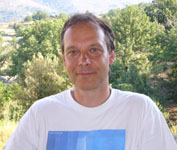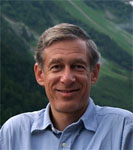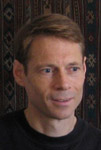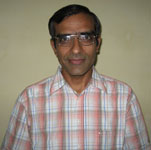|
|
|
 |
Plenary Talk
|
|
::: Wavelets and Differential Operators: from Fractals to Marr’s Primal Sketch :::
|
|
|
Overview: Invariance is an attractive principle for specifying image processing algorithms. In this presentation, we promote affine invariance—more precisely, invariance with respect to translation, scaling and rotation. As starting point, we identify the corresponding class of invariant 2D operators: these are combinations of the (fractional) Laplacian and the complex gradient (or Wirtinger operator). We then specify some corresponding differential equation and show that the solution in the real-valued case is either a fractional Brownian field (Mandelbrot and Van Ness, 1968) or a polyharmonic spline (Duchon, 1976), depending on the nature of the system input (driving term): stochastic (white noise) or deterministic (stream of Dirac impulses). The affine invariance of the operator has two important consequences: (1) the statistical self-similarity of the fractional Brownian field, and (2) the fact that the polyharmonic splines specify a multiresolution analysis of $L_2(\R^2)$ and lend themselves to the construction of wavelet bases. The other fundamental implication is that the corresponding wavelets behave like multi-scale versions of the operator from which they are derived; this makes them ideally suited for the analysis of multidimensional signals with fractal characteristics (whitening property of the fractional Laplacian).
The complex extension of the approach yields a new complex wavelet basis that replicates the behavior of the Laplace-gradient operator and is therefore adapted to edge detection. We introduce the Marr wavelet pyramid which corresponds to a slightly redundant version of this transform with a Gaussian-like smoothing kernel that has been optimized for better steerability. We demonstrate that this multiresolution representation is well suited for a variety of image-processing tasks. In particular, we use it to derive a primal wavelet sketch—a compact description of the image by a multiscale, subsampled edge map—and provide a corresponding iterative reconstruction algorithm.
|
|
|

|
Dr. Michael Unser
Ecole Polytechnique Fédérale de Lausanne (EPFL)
Switzerland
|
|
|
Brief Biography: Michael Unser is Professor and Director of EPFL's Biomedical Imaging Group, Lausanne, Switzerland. His main research area is biomedical image processing. He has a strong interest in sampling theories, multiresolution algorithms, wavelets, and the use of splines for image processing. He has published over 150 journal papers on those topics, and is one of ISI’s Highly Cited authors in Engineering (http://isihighlycited.com).
From 1985 to 1997, he was with the Biomedical Engineering and Instrumentation Program, National Institutes of Health, Bethesda USA, conducting research on bioimaging and heading the Image Processing Group.
Dr. Unser is a fellow of the IEEE and the recipient of three Best Paper Awards from the IEEE Signal Processing Society. He is a member of the Swiss Academy of Engineering Sciences.
|
|
|
::: Light Field Photography and Microscopy :::
|
|
|
Overview: Light field photography is a technique for recording light intensity as a
function of position and direction in a 3D scene. Unlike conventional
photographs, light fields permit manipulation of viewpoint and focus after the
imagery has been recorded. At Stanford we have built a number of devices for
capturing light fields, including (1) an array of 128 synchronized video
cameras, (2) a handheld camera in which a microlens array has been inserted
between the main lens and sensor plane, and (3) a microscope in which a similar
microlens array has been inserted at the intermediate image plane.
The third device permits us to capture light fields of microscopic biological
(or industrial) objects in a single snapshot. Although diffraction limits the
product of spatial and angular resolution in these light fields, we can
nevertheless produce useful perspective flyarounds and 3D focal stacks from
them. Since microscopes are inherently orthographic devices, perspective
flyarounds represent a new way to look at microscopic specimens. Focal stacks
are not new, but manual techniques for capturing them are time-consuming and
hence not applicable to moving or light-sensitive specimens. Applying 3D
deconvolution to these focal stacks, we can produce a set of cross sections,
which can be visualized using volume rendering. Ours is the first technology
(of which we are aware) that can produce volumetric models from a single
photograph.
In this talk, I will describe a prototype light field microscope and show
perspective views, focal stacks, and reconstructed volumes for a variety of
biological specimens. I will also survey some promising directions for this
technology. For example, by introducing a second microlens array and a video
projector, we can control the light field arriving at a specimen as well as the
light field leaving it. Potential applications of this idea include microscope
scatterometry - measuring reflectance as a function of incident and reflected
angle, and "designer illumination" - illuminating one part of a microscopic
object while avoiding illuminating another.
|
|
|

|
Dr. Marc Levoy
Stanford University, California
|
|
|
Brief Biography: Marc Levoy is a Professor of Computer Science and (jointly) Electrical Engineering at Stanford University. He received a Bachelor's and Master's in Architecture from Cornell University in 1976 and 1978, and a PhD in Computer Science from the University of North Carolina at Chapel Hill in 1989. In the 1970's Levoy worked on computer animation, developing an early computer-assisted cartoon animation system. This system was used by Hanna-Barbera Productions from 1983 until 1996 to produce The Flintstones, Scooby Doo, and other shows. In the 1980's Levoy worked on volume rendering, a family of techniques for displaying sampled three-dimensional functions, for example computed tomography (CT) or magnetic resonance (MR) data. In the 1990's he worked on technology and algorithms for digitizing three-dimensional objects. This led to the Digital Michelangelo Project, in which he and a team of researchers spent a year in Italy digitizing the statues of Michelangelo using laser scanners. His current interests include light field sensing and display, computational photography, and applications of computer graphics in microscopy and biology. Awards: Charles Goodwin Sands Medal for best undergraduate thesis (1976), National Science Foundation Presidential Young Investigator (1991), ACM SIGGRAPH Computer Graphics Achievement Award (1996), ACM Fellow (2007). Recent professional service: Papers Chair of SIGGRAPH 2007.
|
|
|
::: Scene Segmentation with Latent Topic Markov Field Models
- and -
Classification and Dimensionality Reduction using Convex Class Models :::
|
|
|
Overview: The talk will be in two parts. In the first part I will present work
with Jakob Verbeek on semantic-level scene segmentation by combining
spatial coherence models such as Markov and Conditional Random Fields
with latent topic based local image content models such as
Probabilisitic Latent Semantic Analysis over bag-of-words
representations. In the second part I will present some work
with Hakan Cevikalp, Frederic Jurie and Robi Polikar on using simple
convex approximations to high-dimensional classes for multi-class
classification and discriminant dimensionality reduction.
|
|
|

|
Dr. Bill Triggs
Centre National de Recherche Scientifique (CNRS)
France
|
|
|
Brief Biography: Professor Triggs is an ex mathematical physicist turned computer vision and pattern recognition researcher employed by France's main national research organisation, the Centre National de Recherche Scientifique (CNRS). He works in (and is deputy director of) the Laboratoire Jean Kuntzmann (LJK) in Grenoble in the heart of the French Alps. LJK is a newly created applied mathematics and computer science research laboratory associated with the CNRS and three Grenoble universities (UJF, INPG, UPMF) and with links to INRIA's Rhône-Alpes research unit.
Nowadays he works mainly on applying statistical pattern recognition and machine learning to visual object recognition and scene understanding, but he is also known for his work on vision geometry (matching constraints, scene reconstruction, auto-calibration, etc) and on human body tracking. He has been associated with several robotics and computer vision research teams in Grenoble : SHARP (now e-Motion) from 1993 to 1995; MOVI (now PERCEPTION) from 1995 to 2003; and LEAR from 2003 to 2007. Before that he worked on robotic planning and mobile robotics in Oxford University's Robotics Research Group.
|
|
|
::: Scene and Pose Associated Camera Motion Synthesis :::
|
|
|
Overview: Synthesis and control of camera motion is one of the essential
components in animation. In this talk we present our work that
demonstrates authoring of camera motion in two scenarios:
a) planning walkthroughs of a scene, where camera responds
to the scene contents, and b) creating 3D character animation with
moving camera, where camera accounts for the pose of the character
specified.
In the first scenario, the emphasis is given on designing a walkthrough
of a scene with the knowledge of interesting and uninteresting parts of
the scene. The approach developed offers a walkthrough so that the
camera looks at the interesting objects for the most part of the tour.
Further the speed can also be controlled from the quality of the scene
being seen. A graph theoretic optimization scheme is adopted that
computes optimal gaze and speed of the camera at sampled points on a
specified path.
For the second scenario, we introduce a framework of view-dependent
animation that embodies the association of the character pose and the
camera (or the view). Typically, an animator while making the storyboard
specifies the character pose with desired camera for the key views.
A space called "view space" is generated using the key cameras
and associated character poses. A desired animation holding the camera
pose association can be generated by tracing a path in the view space.
This work is done in collaboration with Subhashis Banerjee, Subhajit
Sanyal and Parag Chaudhury.
|
|
|

|
Dr. Prem K Kalra
Indian Institute of Technology, Delhi
|
|
|
Brief Biography:
Prem Kalra is a professor in the Department of Computer Science and
Engineering at the Indian Institute of Technology (IIT), Delhi. He is
with IIT Delhi since Dec 1997. Before joining IIT Delhi, he was at
University of Geneva (Switzerland). He did BSc Mechanical Engineering
from (Dayalbagh) Agra University, India, MTech in Industrial Engineering
from IIT Delhi, MS in Computer Science from University of New
Brunswick, Canada and PhD in Computer Science from Swiss Federal
Institute of Technology- Lausanne (EPFL), Switzerland. His research
interests include computer vision based modeling and rendering, 3D
visualization and animation, and image/video super-resolution. He has
published more than 50 papers in the reputed international journals and
conferences.
|
|
|
|

